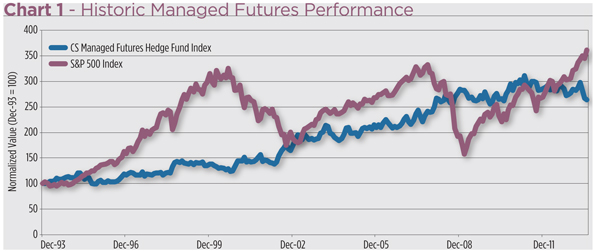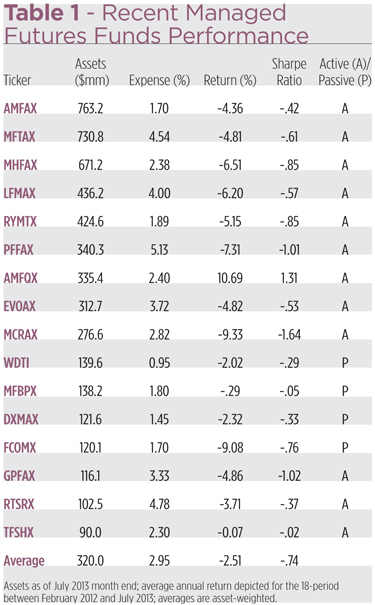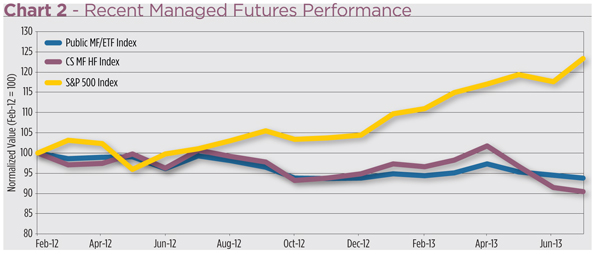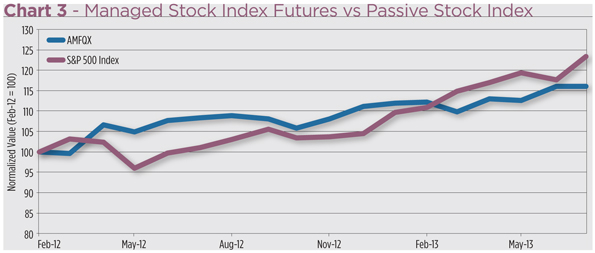In all chaos there is a cosmos, in all disorder a secret order -- Carl Jung.
Navigating through chaos is the daily charge of investment managers. Since futures contracts represent one of the most unpredictable asset classes, advisors who trade commodities must, ipso facto, be experts in managing chaos.
On the surface, the track record of futures hedge funds supports this notion. Over the past two decades, managed futures portfolios, measured by the Credit Suisse Managed Futures Hedge Funds Index[1], earned a Sharpe ratio of .47 versus -.19 booked by the S&P 500 Composite. That means over the long run, the rewards earned by actively managed futures funds more than compensated investors for the risks undertaken. Not so for buyers of passive exposure to domestic equities.

Nothing illustrates the risk disparity better than a comparison of the depth and length of each asset’s drawdowns. A drawdown represents a low point in an investment’s value before a new high is reached. In the past 20 years, the S&P 500’s deepest drawdown was 53 percent while the managed futures index was down no more than 18 percent before hitting a new high. Equity drawdowns, too, have been longer than those suffered by commodity funds. Though there’s not much difference in the average length (eight months for managed futures, 11 for the S&P), stocks’ longest drawdown -80 months between September 2000 and April 2007- was nearly three times lengthier than commodities’ lengthiest trough.
These aren’t reason enough to go willy-nilly into the futures pits. Recent market momentum should give potential investors pause. Blue chips have gained more than 25 percent in the past two years while managed futures slipped 11 percent. The wind has clearly been at the back of equities, not commodity trading, coming out of the Great Recession.
Still, given the extraordinary financial environment, it’s fair to ask if the managed futures/passive equities paradigm will revert to its 20-year norm (advantage: futures). And, if so, is there a way for non-accredited investors to enjoy the benefit?
Several recently introduced ’40 Act products allow retail investors access to the managed futures space. Sixteen of them are directly comparable, in terms of size and maturity, to the components of the Credit Suisse Managed Futures Hedge Funds Index.
Publicly traded managed futures funds aren’t setting the world on fire. Collectively, they’re limping along, nursing yearly losses of 2.5 percent while the S&P 500 gallops ahead at a 15.6 annual pace. Public funds, thus, earn a -.04 alpha coefficient. Still, retail investors are doing better than their accredited cousins. Managed futures hedge funds score -.07 on the alpha meter due to their 6.4 percent annualized losses. Because they exhibit less price volatility, though, hedge funds earn a better (-.61) Sharpe ratio.


Passive products
Most of the large public managed futures funds are, as the category name implies, traded on a discretionary basis. The humans at the helm of these funds decide which levers to pull and when to twist the knobs to set their courses. A handful, however, are actually index trackers. Or, more properly, mechanistic strategy trackers. Consider the WisdomTree Managed Futures Strategy Fund (NYSE Arca: WDTI), the sole exchange-traded fund in our universe. WDTI follows the Diversified Trends Indicator, a quantitative, rules-based strategy that assigns long or short positions among two dozen commodities based upon their rising or declining price trends.
Three other public portfolios are similarly managed: the Aspen Managed Futures Strategy Fund (OTC: MFBPX), the Direxion Indexed Managed Futures Strategy Fund (OTC: DXMAX) and the Forward Commodity Long/Short Strategy Fund (OTC: FCOMX).
All, like WDTI, are driven by momentum strategies. MFBPX tracks the Aspen Managed Futures Beta Index, a model that allocates short and long positions from a universe of 23 futures. The field of components for DXAMX’s Auspice Managed Futures ER Index is slightly smaller while that utilized by FCOMX’s Credit Suisse Momentum and Volatility Enhanced Return Strategy (MOVERS) Index is marginally broader.
These portfolios are homogeneous in other ways. First of all, their returns are better than those of the active portfolios. (Perhaps it’s better to say they’re “less worse.”) The average passive portfolio posted a 3.4 percent annual loss recently while active portfolios lost 3.9 percent. Part of the performance differential is due to the passive portfolios’ lower cost structure. Expense ratios averaged 1.48 percent for the index products versus 3.25 percent for the active funds.
Though none of the passive portfolios are producing gains now, they represent better reward-to-risk propositions than most active funds. That’s reflected in their Sharpe ratios: index products earn a mean ratio of -.36 compared to -.56 posted by the discretionary portfolios.
Notable active funds
A few active funds stand out from the pack. The largest, with more than $763 million in assets, is the Natixis ASG Managed Futures Strategy Fund (OTC: AMFAX). The fund’s been seasoned since its July 2010 launch, though it’s not the oldest fund in the category.
AMFAX managers take a multi-model approach in their attempt to detect trends over a range of time horizons. Portfolio runners look for opportunities in more than 70 different commodity futures contracts and currency forwards.
AMFAX’s annualized return, though still negative, is among the top five in the active category. Its Sharpe ratio, too, is better than average, but AMFAX’s cost is what really makes the portfolio notable. The fund’s 1.70 percent expense ratio is the lowest of all the active portfolios.
The category’s oldest ticker symbol is paradoxically its youngest fund. The Guggenheim Managed Futures Strategy Fund (OTC: RYMTX) began life as a Rydex fund in 2007. Then it was a tracker of the Diversified Trend Indicator, the benchmark now followed by WDTI. Starting in July 2011, RYMTX began its transition away from passive management until January 2013 when the fund became a full-fledged active product. RYMTX has the third-best return and Sharpe ratio in the category.
The youngest active fund ticker belongs to the TFS Hedged Futures Fund (OTC: TFSHX) that is, no surprise here, also the smallest fund in the category. Launched in December 2011, the fund’s managers focus on finding complementary positions to hedge away market risk. Dispensing risk can also hedge away profits, but in the current environment the fund’s strategy has paid off. Essentially, the fund has broken even, no mean feat considering the active funds’ average annual losses. Thus, TFSHX earns the category’s second-best return and Sharpe ratio.
The only fund, active or passive, that’s actually produced a gain over the past 18 months is the 361 Managed Futures Strategy Fund (OTC: AMFQX). Though the fund’s performance has lagged the S&P 500 for most of 2013, AMFQX earned .11 in alpha for the period.
Brian Cunningham, president and chief investment officer of fund sponsor 361 Capital LLC, attributes his fund’s outperformance to its narrow focus. “The 361 Managed Futures Fund invests solely in U.S. stock index futures. We believe many managed futures funds are overdiversified which drives down returns,” says Cunningham. He prefers to concentrate on deeper and more liquid markets to allow his proprietary algorithms to better exploit behavioral biases.

AMFQX employs a strategy that’s designed, according to Cunningham, to take advantage of choppy and volatile markets. “Most CTAs utilize longer term trend following strategies which have struggled over the last few years due to a lack of sustained trends,” he explains. “Short term countertrend strategies tend to be more consistent across market cycles as the hit ratio, or percentage of profitable trades, often exceeds 70 percent.” Trend following strategies, in contrast, typically chalk up ratios of only 25 to 40 percent.
Those statistics drive AMFQX’s investment philosophy. The fund, at any given time, is tactically invested at the 100 percent level, i.e., all long, all short or all cash. “We take full -- that is, 100 percent -- positions due to the high hit ratio,” says Cunningham.
Despite the fund’s concentration in U.S. stock index futures, AMFQX’s countertrend strategy yields no correlation (r2 .00, beta -.02) to the S&P 500. That makes the fund a suitable risk diversifier for stock-heavy portfolios.
When considering a managed futures investment, the question for most investors and their advisors is how much capital to allocate. “Most accounts could benefit from an investment in a strategy such as managed futures,” says Cunningham. But, he cautions, a daub just won’t do. “If a portfolio is to benefit from a managed futures investment, the allocation should be no less than five percent. Anything less has little impact on the overall portfolio.”
[1]The index is comprised of 34 CTA-managed funds, each with more than $50 million in assets, a track record of at least 12 months and current audited financials.






